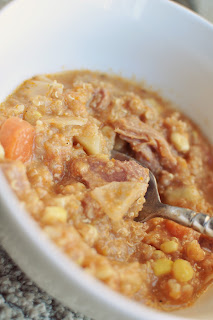My little family and I took a trip several weekends ago to a pick-your-own-vegetables farm. It was a great time. Our little one loved picking "geen beans" and "sqash" and "totatoes". We bounced along on a hayrack ride between the fields, and she loved that too. Mommy and Daddy loved picking well over $100 worth of fresh produce for only $30. We seriously picked a LOT. We have an entire rubbermaid container full of butternut squash, another one of acorn squash, another one full of corn and potatoes, and a fridge full of tomatoes, green beans, carrots, onions, turnips, and beets. Grocery budget win! Anyway, I spent that week shucking corn, snapping beans, and chopping onions. As well as making spaghetti sauce from all the tomatoes. I used this basic recipe from Smitten Kitchen (genius!) for the tomato sauce: http://smittenkitchen.com/blog/2010/08/fresh-tomato-sauce/ I made a few minor modifications. I used tomato, olive oil, garlic, and onion, but I also added basil and a tablespoon or two of sugar. And salt of course. I also cheated and stretched my sauce a bit with a can of store bought spaghetti sauce. It turned out lovely and caramelized, with a beautiful, full bodied flavor. Unfortunately, my sink of tomatoes only turned out about 8 cups of sauce. Anyhow, I used two cups of that sauce as the base for this vegetable soup.

It gives it a depth of flavor that a simple can of crushed tomatoes (my usual go to) can't dream of competing with. Yum. Vegetable soup is a great recipe to personalize because of it's versatility. I used potatoes, carrots, cabbage, and corn. You can use literally any vegetable combination that floats your boat. I used ham with a combination of beef and chicken broth. You can use ground beef, chicken, steak, or even shrimp, with any broth. Whatever your little heart desires. Here is my personal favorite combination. It's by far the best vegetable soup I've ever come up with, and will now be my stand by. I love the sweetness of the carrots and corn with the heartiness of potatoes. The caramelized hint of onions and cabbage with the slight acidity from the tomato sauce. The salty, smoky ham with the modest bite of the quinoa. Mmm, mmm, good. And on another note, I tried a bowl of it over some leftover mashed potatoes and carrots, and that was great too!
Heart Health Highlight
Carrots- these flaming orange beauties are, of course, packed with beta-carotene, an important antioxidant to help
combat free-radical cell damage and a fearsome foe in the world of heart
disease. One mere cup of cooked carrots provides a walloping punch- 300% of your
recommended daily intake. Cook with olive oil to help with absorption. They
also contain calcium pectate, a type of pectin fiber thought to help remove
cholesterol from the body. Finally, carrots have a healthy portion of insoluble
fiber and vitamin A, both of which help in numerous body functions.
Cabbage- this sweet little gem (the
best cabbage is always sweet!) is full of insoluble fiber, beta-carotene,
folate, and vitamin C. It also contains dithiolethiones, compounds which may
guard against carcinogenic agents and increase glutathione, an antioxidant. All
of these things help in the fight against heart disease!
Garlic- Garlic has anticlotting
properties, possibly due to the ajoenes present. Also, the sulfur
phytochemicals may help protect against heart disease.
Tomatoes- Tomatoes are abundant in
lycopene, a strong antioxident that may help prevent cell damage that leads to
heart attacks. They are also rich in vitamin C, which may help protect against
heart disease. Oil helps you absorb lycopene, so toss in some olive oil.
Corn- Corn often gets a bad rap as
being without significant nutrients, but actually is a great source of complex
carbs, folate, and soluble fiber, which may help protect against heart disease.
Quinoa- Considered a
"super grain", Quinoa is an excellent source of heart-healthy
magnesium and vitamin E, as well as cholesterol-reducing plant sterols,
saponins, and rutin.
Olive
Oil- This healthy oil
contains disease-fighting phytochemicals, vitamin E, and monounsaturated fat.
All these help keep arteries clear of cholesterol. The monousaturated fat may
also help raise good cholesterol, and a diet rich in this fat may help lower
your chance of heart disease.
Source: Fight
Back with Food: Use Nutrition to Heal What Ails You, The Reader's
Digest Association
Home Style Vegetable Soup
1/4 cup olive oil
1/4 small onion, chopped
3-4 potatoes, chopped
3-4 carrots, chopped
1/4 of a cabbage, chopped (or about 2 cups)
3-4 cloves of garlic, minced
2 cups corn
2 cups spaghetti sauce
6-8 cups chicken or beef or ham broth
2 cups cooked quinoa
2 cups diced, cooked ham
1/4 cup cornmeal stirred into 1 cup of milk
sea salt, as needed
Heat the olive oil over medium heat and add the onion. Saute until slightly softened, then add in the carrots, potatoes, and cabbage. When the vegetables start to soften, add in the garlic and corn. Continue to saute until you get some lovely light browning and the veggies are almost completely cooked. Now add the spaghetti sauce, and saute for a couple minutes more. Add the broth (use more or less, to make it as brothy as you'd like) and allow the soup to simmer on low for 30-40 minutes up to an hour, to allow the flavors to get richer and the veggies to finish cooking. Add in the quinoa, ham, and the cornmeal/milk mixture. Allow to simmer for another 15 minutes, taste and salt as needed, and serve all toasty warm and comforting.
*Optional: to serve over mashed potatoes and carrots, simply boil carrots and potatoes until tender, then mash with milk, butter, salt, cream cheese, and a dash of garlic powder. Then mash/whip as desired.




No comments:
Post a Comment